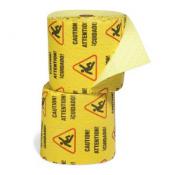Workplace cold weather advice and safety tips for the winter months

Icy winter conditions pose workplace risks for your plant and people
Winter is here, and cold temperatures bring unique safety risks for those who work outdoors. For instance, frostbite and hypothermia are risks due to lost body heat (especially when wearing wet clothing). Additionally, slip hazards increase during outdoor activities like de-icing equipment and vehicles.
Make sure your workplace and employees are ready to face the elements this winter season. As the temperature drops, help prepare for potential hazards with the following winter safety tips and advice.
What’s so dangerous about winter?
Winter weather can be dangerous in different ways, from the effects of wind and rain to snow and cold temperatures. The key is to properly prepare for winter weather conditions. Thus, determine how conditions may affect your facility, equipment, and employees.
Here are just a few safety issue scenarios and solutions to consider:
1. Slippery surface hazards
Does water or ice turn certain stairs or ramps into slip-and-fall hazards? Installing permanent safety treads can head that problem off. More so, they save time and money rather than sprinkling rock salt every day. Indoors, industrial absorbent mats help keep floors clean and dry. You can say goodbye to puddles from wet work boots or umbrella drips.
2. Potential structural damage
Will winter storm rain or snow meltwater pose structural building risks, like roof damage? Make sure you’re prepared with the right stormwater management products. For example, a temporary and easy-to-install roof leak diverter.
3. Frozen pipes
Likewise, burst pipes and ruptures are other common occurrences in freezing temperatures. However, having an emergency kit for leaks ready to go can quickly halt equipment damage. Moreover, save you from facing an expensive repair bill.
4. Heating risks
Does your facility or warehouse rely on devices like gas-fueled space heaters for warmth? Without correct ventilation, a dangerous build-up of carbon monoxide is possible. Install a battery power CO detector as an alert against carbon monoxide poisoning. But don’t forget to check your detector every year to make sure it is in good working order. And always keep a stock of extra batteries in your emergency supplies!
5. Personnel health
And of course, protecting your employees from health problems in cold conditions should be a top priority. In extremely cold conditions, hypothermia—an abnormally low body temperature—poses a very serious health risk. Warning signs in adults include shivering, exhaustion, confusion, slurred speech, and drowsiness. If your employees start to exhibit these symptoms, seek medical care immediately. Especially if their temperature falls below 95° F.
Staying safe in winter while working outdoors

Monitor body temperature during frigid outdoor activities like shoveling snow
Unfortunately, wintertime doesn’t always allow for job sites and work activities to move indoors. Especially for service industries such as construction and maintenance crews. In many regions of the United States, snow removal using snow blowers or shoveling is a necessity to keep operations running smoothly.
That’s why it’s essential to educate staff on basic cold-weather safety tips. Like knowing the warning signs of hypothermia and frostbite. Help them to stay safe by ensuring they understand the importance of:
- Dressing in appropriate layers for the weather. This includes hats, gloves/mittens, and outerwear;
- Taking frequent breaks in warm, dry areas to allow their bodies to recover;
- Eating and drinking warm, high-calorie foods and beverages as well as avoiding alcohol and caffeine; and
- Avoiding fatigue because the body uses a lot of energy to keep warm.
Healthy bodies are better equipped to handle extreme temperatures and weather conditions. That means, one way you can prepare for the changing season is with overall health and fitness!
The best preparation is comprehensive training
Your best tool against cold-induced injuries and illnesses is an informed, well-trained staff. Here are some areas in which you should train your workforce:
- Prevention — Being aware of all cold weather risks gives you the opportunity to prevent some of the dangers. Prevention training will ensure you have the safety materials you need to get your workforce through the winter without a hitch.
- Identification — Employees should be able to recognize and identify different cold-induced illness and injury symptoms and signs in themselves and others. The sooner you identify problems, the sooner you can treat them.
- Treatment — You should train your workforce in proper first aid to allow members to treat cold-induced injuries and illnesses. Knowing the right steps to take if someone starts showing trench foot or hypothermia signs could turn a possibly major injury into something minor.
OSHA’s website provides many workplace winter safety tips, including winter driving and a cold stress guide. As well, the CDC offers helpful publications such as preventing cold-related injuries for workers.
Useful winter safety supplies for your workplace
As we mention above, preparing your workplace to tackle cold conditions is a must. Help ensure a safer winter season with our list of workplace emergency supplies:
- Non-slip absorbent floor mats can soak up wet foot traffic in entryways and prevent workers from taking a spill.
- Granular absorbents and sorbent pads quickly clean up chemical spills like antifreeze and stop slick surfaces or icy water puddles.
- Emergency leak repair kits will deal with pipe ruptures, roof leaks, and more.
- Caution tape and caution mat pads can easily alert about hazards like wet floors.
- Orange safety cones or vertical panel barricades with safety messages are other great options to warn workers about potential dangers.
Even in this modern age, winter weather can be extremely dangerous for the unprepared. Don’t get caught out in the cold: Plan for winter workplace safety.
Have questions about which absorbents are right for your needs? Contact Travis Zdrazil at travis@absorbentsonline.com or (800) 869-9633.
This is a revision to a blog post with an original publication date of December 6, 2016.

